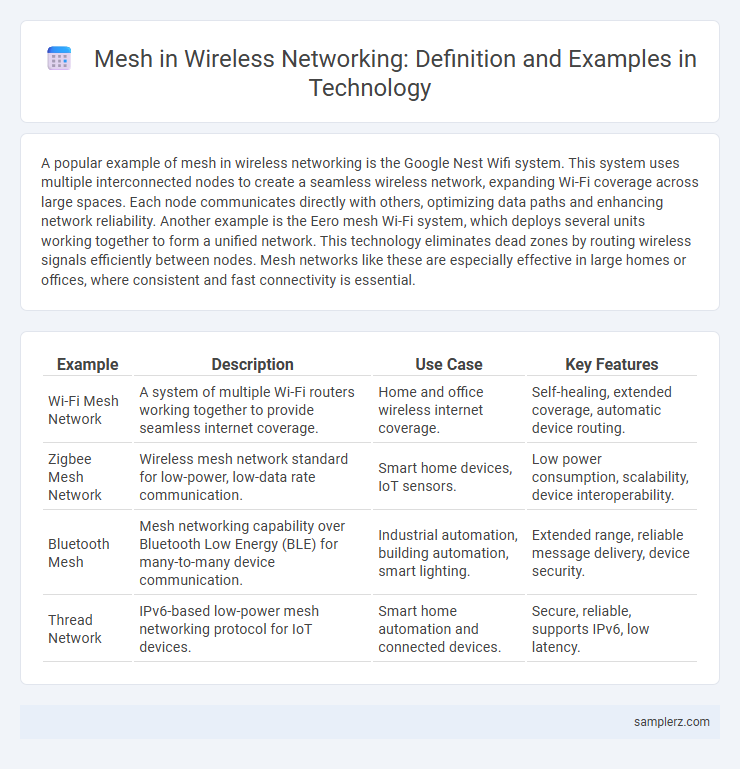A popular example of mesh in wireless networking is the Google Nest Wifi system. This system uses multiple interconnected nodes to create a seamless wireless network, expanding Wi-Fi coverage across large spaces. Each node communicates directly with others, optimizing data paths and enhancing network reliability. Another example is the Eero mesh Wi-Fi system, which deploys several units working together to form a unified network. This technology eliminates dead zones by routing wireless signals efficiently between nodes. Mesh networks like these are especially effective in large homes or offices, where consistent and fast connectivity is essential.
Table of Comparison
| Example | Description | Use Case | Key Features |
|---|---|---|---|
| Wi-Fi Mesh Network | A system of multiple Wi-Fi routers working together to provide seamless internet coverage. | Home and office wireless internet coverage. | Self-healing, extended coverage, automatic device routing. |
| Zigbee Mesh Network | Wireless mesh network standard for low-power, low-data rate communication. | Smart home devices, IoT sensors. | Low power consumption, scalability, device interoperability. |
| Bluetooth Mesh | Mesh networking capability over Bluetooth Low Energy (BLE) for many-to-many device communication. | Industrial automation, building automation, smart lighting. | Extended range, reliable message delivery, device security. |
| Thread Network | IPv6-based low-power mesh networking protocol for IoT devices. | Smart home automation and connected devices. | Secure, reliable, supports IPv6, low latency. |
Introduction to Mesh Networking in Wireless Technology
Mesh networking in wireless technology creates a decentralized communication framework where each device, or node, connects directly and dynamically with multiple other nodes to efficiently route data. This structure enhances network reliability and coverage by allowing seamless self-healing and load balancing across the network. Common applications include smart cities, IoT devices, and home automation systems, where consistent connectivity is critical.
Key Features of Wireless Mesh Networks
Wireless mesh networks feature decentralized architecture, enabling nodes to communicate directly or through intermediate nodes, enhancing network reliability and scalability. Self-healing capabilities allow automatic rerouting of data when a node fails, ensuring uninterrupted connectivity. These networks support dynamic topology, facilitating easy expansion and efficient resource allocation in environments like smart cities and industrial IoT applications.
Mesh Topology: How Devices Communicate
Mesh topology in wireless networking enables devices to communicate directly with multiple other nodes, creating a decentralized and resilient network structure. Each device (or node) acts as both a sender and receiver, automatically routing data through the most efficient path based on current network conditions. This dynamic communication method reduces single points of failure and enhances network coverage, especially in environments requiring robust connectivity.
Common Use Cases for Wireless Mesh Networks
Wireless mesh networks are commonly deployed in smart city infrastructure to provide reliable and scalable connectivity for public Wi-Fi, traffic management, and environmental monitoring systems. They are widely used in industrial settings to support real-time data exchange between sensors, machinery, and control units, enhancing automation and operational efficiency. Emergency response teams rely on wireless mesh networks to establish rapid communication channels in disaster-stricken areas where traditional networks are unavailable or compromised.
Home Mesh Wi-Fi Systems: Popular Examples
Home Mesh Wi-Fi systems such as Google Nest WiFi, Netgear Orbi, and Eero provide seamless wireless coverage by using multiple interconnected nodes to eliminate dead zones. These systems optimize network performance through dynamic routing and automatic band steering, ensuring consistent connectivity for smart home devices. Advanced features include easy setup via mobile apps, parental controls, and integration with voice assistants like Amazon Alexa or Google Assistant.
Enterprise-Grade Mesh Solutions
Enterprise-grade mesh solutions, such as Cisco Meraki and Aruba Instant Mesh, provide scalable and reliable wireless networking for large organizations. These systems use multiple interconnected access points to ensure seamless coverage and high throughput across complex office environments. Advanced features like self-healing capabilities and centralized management optimize network performance and security for critical business operations.
IoT Applications Leveraging Mesh Networks
Mesh networks in wireless technology enable IoT devices to communicate efficiently through decentralized nodes, enhancing coverage and reliability in smart homes and industrial automation. Sensor networks in agriculture utilize mesh architecture to monitor soil conditions and optimize irrigation by maintaining continuous data flow even with node failures. Smart city applications deploy mesh networks to support connected streetlights, traffic signals, and environmental sensors, ensuring scalable and resilient urban infrastructure management.
Pros and Cons of Wireless Mesh Networks
Wireless mesh networks provide robust coverage through interconnected nodes that dynamically route data, enhancing network reliability and scalability. They excel in environments requiring flexible deployment and self-healing capabilities, reducing dependency on centralized infrastructure. However, increased latency and interference may occur as network size grows, and managing security across multiple nodes presents significant challenges.
Scalability and Flexibility of Mesh Architectures
Mesh architectures in wireless networking enable seamless scalability by allowing new nodes to be added without significant reconfiguration, supporting extensive coverage in large-scale environments. The decentralized nature of mesh networks enhances flexibility, as each node independently manages data routing, ensuring robust connectivity despite node failures or dynamic topology changes. This adaptability makes mesh networks ideal for applications requiring resilient communication across fluctuating or expansive areas like smart cities and industrial IoT deployments.
Future Trends in Mesh Networking Technology
Future trends in mesh networking technology emphasize enhanced scalability and AI-driven network management, enabling dynamic self-healing and optimized routing in complex wireless environments. Integration of 5G technology and IoT devices will drive ultra-low latency and high-throughput connectivity across smart cities and industrial applications. Advanced security protocols and edge computing capabilities will further strengthen mesh networks, ensuring robust protection against cyber threats while supporting real-time data processing.

example of mesh in wireless networking Infographic
 samplerz.com
samplerz.com